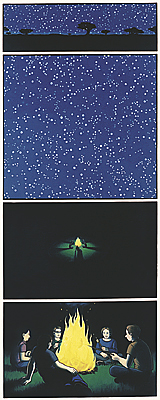| Umělec 1997/4 >> Moments of the Everyday | Просмотр всех номеров | ||||||||||||
|
|||||||||||||
Moments of the EverydayUmělec 1997/401.04.1997 Umělec | artist | en cs |
|||||||||||||
|
"Simone Letto lives in Düsseldorf, Germany where she graduated from the Art Academy. Since 1990, she presented her work in several solo exhibitions in Düsseldorf, Gütersloh and Frankfurt and took part in many group shows in Germany. Her paintings are typical for telling banal stories using the easiest means of painting without any additional effects. This straightforward presentation of a ministory in chronological sequence enables Letto to reach magical appeal of her paintings in which the time has stopped.
Your paintings remind more of a film recording. What meaning does the medium of painting bare for you? For me, the activity of painting itself is important; the way the single panels are composed. Painting gives the possibility of showing different scenes at one time not just one after another like in a film. A film has a fixed time sequence whether it’s for two hours or fifteen seconds for which it takes to watch. My work has no such limitations placed upon it. The viewer can take his or her time when viewing the work. My work is completely fictional, people and places are not based on reality and are not needed to be. The ideas or stories are based more on general themes that have less to do with specific personalities or real places. Can a painted picture still meaningfully express some sort of a story? Yes, I think so. Every figurative image has the possibility of communicating a story or an idea whether from the artist and/or from the viewers’ own interpretation. Today, artists have more competition from other means of modern and advanced forms of communication (Internet, television, etc.). This makes the artist’s task much harder but also much more important in communicating an idea in a very personal way and hopefully not only for general consumption. What story do your paintings try to tell? They are not really meant to tell „stories“ per se. They are rather a short glimpse or a vignette of moments in everyday life. These „moments“ I chose to show have no beginning or end. The last panel in any of my paintings does not draw a final conclusion but is left open to continue. Are you inspired by other visual media such as video, advertising, etc? I am more inspired by personal social interaction and streetlife. Even though your paintings are shining with colors and happy forms, one can feel some kind of anxiety, fear and loneliness in them. Are these topics something you are interested in? Although these emotions could be interpreted in my work, they are by no means the main core or reason behind these images. I feel that loneliness, anxiety and fear are very much a part of our society today, especially here in Germany. People tend to get isolated from one another and being that our environment influences us, this could influence my work. How did you come to your themes? What preceded your current work and how will you develop it? In my earlier work, I focused more on singular images for some years. One day I stopped painting and started doing drawings on paper in the form of picture-stories, sometimes with text. These earlier works were more story-oriented. They were a bit more complicated with less attention placed on composition. In the later work, the „story“ was simplified with more attention placed on technique and composition. For the future, it is hard to tell how my work will develop. "
01.04.1997
Рекомендуемые статьи
|
|||||||||||||








Комментарии
Статья не была прокомментированаДобавить новый комментарий